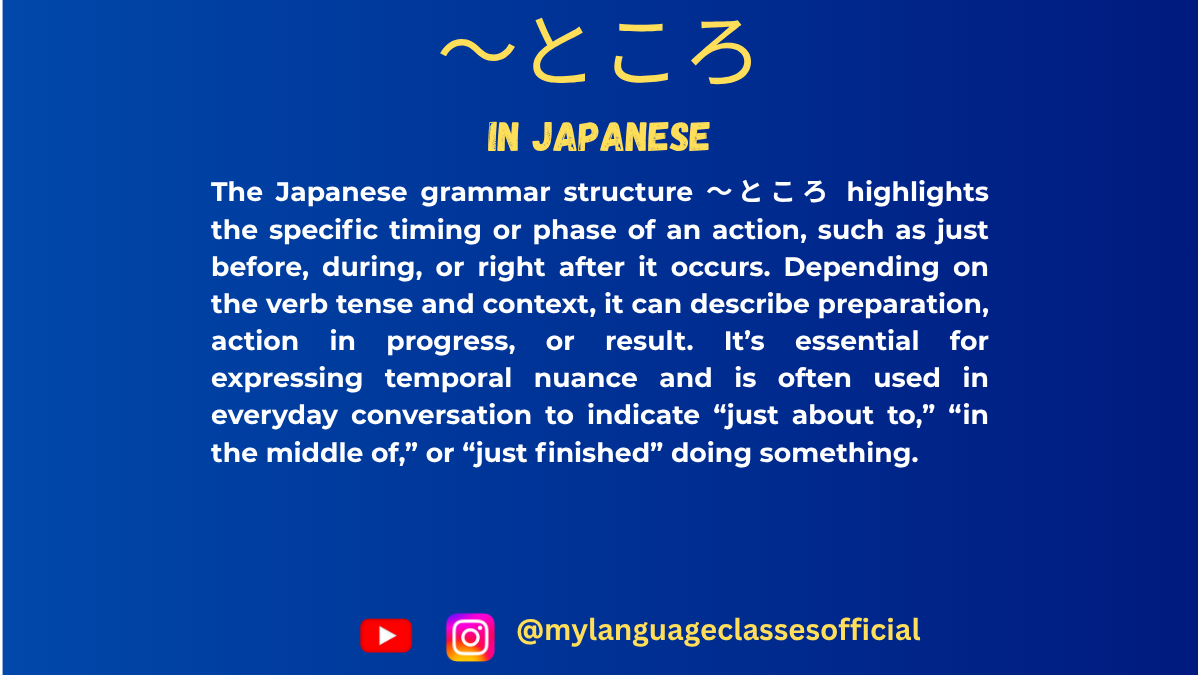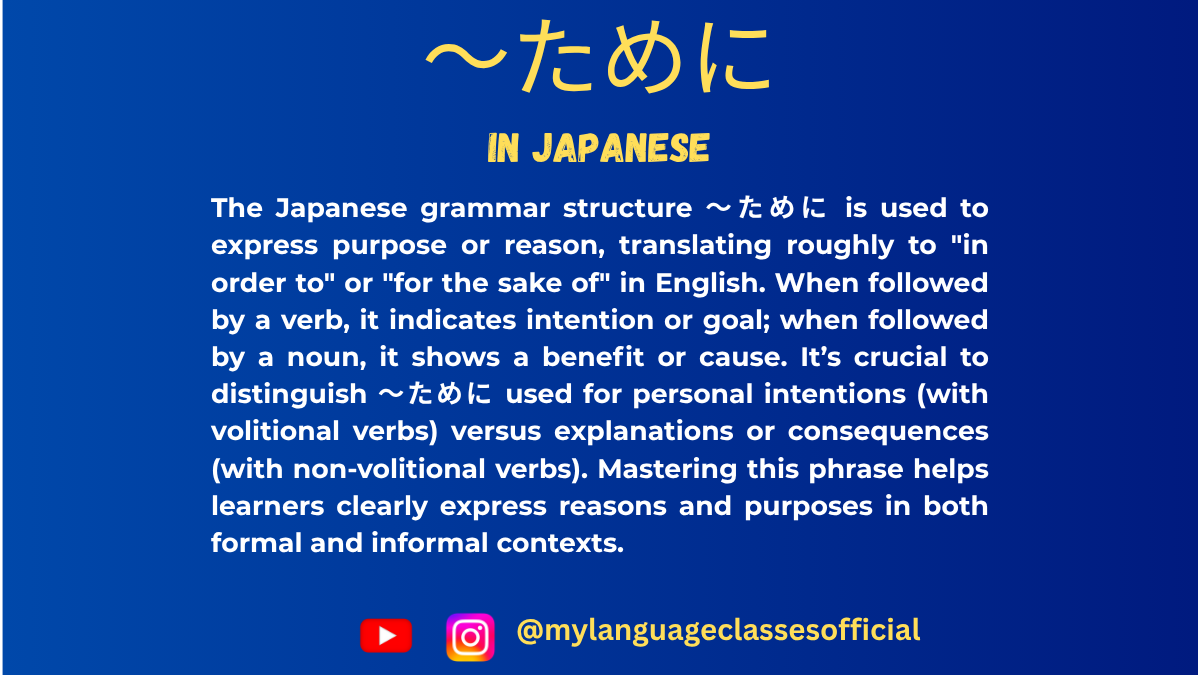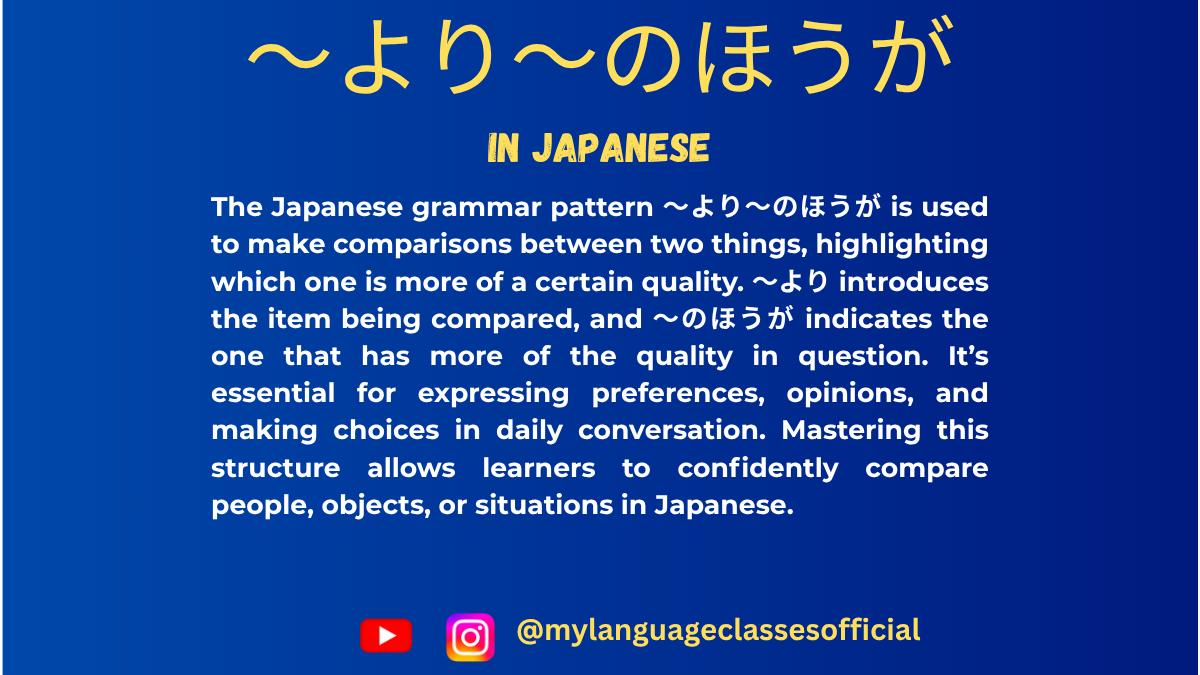Your cart is currently empty!
Tag: Japanese study guide
-

How to Use 〜ところ in Japanese | My Language Classes
Using 〜ところ Form in Japanese
The 〜ところ form is a crucial grammatical structure in Japanese that expresses different stages of an action. It helps indicate whether an action is about to happen, is in progress, or has just been completed. This blog post will cover the formation of 〜ところ for all three verb groups, its various uses, and provide example sentences, things to keep in mind, exercises, and a conclusion.
Formation of 〜ところ Form
Group 1 (Ichidan Verbs)
For ichidan (一段) verbs, remove る from the dictionary form and add the appropriate auxiliary:
- Before the action: 〜るところ
- During the action: 〜ているところ
- After the action: 〜たところ
Example:
- 食べる (taberu – to eat)
- Before: 食べるところ (taberu tokoro)
- During: 食べているところ (tabete iru tokoro)
- After: 食べたところ (tabeta tokoro)
Group 2 (Godan Verbs)
For godan (五段) verbs, use the same rules as ichidan verbs but conjugate accordingly:
- Before the action: Dictionary form + ところ
- During the action: て-form + いるところ
- After the action: た-form + ところ
Example:
- 読む (yomu – to read)
- Before: 読むところ (yomu tokoro)
- During: 読んでいるところ (yonde iru tokoro)
- After: 読んだところ (yonda tokoro)
Group 3 (Irregular Verbs)
For irregular verbs like する and くる:
- する (suru – to do)
- Before: するところ (suru tokoro)
- During: しているところ (shite iru tokoro)
- After: したところ (shita tokoro)
- くる (kuru – to come)
- Before: くるところ (kuru tokoro)
- During: きているところ (kite iru tokoro)
- After: きたところ (kita tokoro)
Usage of 〜ところ
Situations where 〜ところ is used:
Situation Form Used Example Right before an action るところ 今から寝るところです。 (I’m just about to sleep.) In the middle of an action ているところ ちょうど宿題をしているところです。 (I am in the middle of doing my homework.) Just after an action たところ ちょうどご飯を食べたところです。 (I just finished eating.) To indicate an important moment る・ている・たところ 試験を受けるところだった。(I was just about to take the exam.) When explaining a sequence of events たところ 先生に聞いたところ、すぐに答えがわかった。(When I asked the teacher, I immediately understood the answer.)
Example Sentences
- 電車が出発するところです。
Densha ga shuppatsu suru tokoro desu.
(The train is about to depart.) - 彼は今、電話しているところです。
Kare wa ima, denwa shite iru tokoro desu.
(He is on the phone right now.) - ちょうど昼ご飯を食べたところです。
Choudo hirugohan o tabeta tokoro desu.
(I just finished eating lunch.) - 飛行機が今にも飛ぶところです。
Hikouki ga ima ni mo tobu tokoro desu.
(The airplane is just about to take off.) - 友達と話しているところでした。
Tomodachi to hanashite iru tokoro deshita.
(I was in the middle of talking with my friend.) - 彼に聞いたところ、すぐに答えてくれました。
Kare ni kiita tokoro, sugu ni kotaete kuremashita.
(When I asked him, he answered immediately.) - ちょうど今、家を出るところです。
Choudo ima, ie o deru tokoro desu.
(I am just about to leave home.) - 映画を見ているところです。
Eiga o mite iru tokoro desu.
(I am in the middle of watching a movie.) - 買い物が終わったところです。
Kaimono ga owatta tokoro desu.
(I just finished shopping.) - 勉強するところだったのに、友達が来ました。
Benkyou suru tokoro datta noni, tomodachi ga kimashita.
(I was about to study, but my friend came.)
Things to Keep in Mind
- 〜ところ emphasizes timing rather than the state of an action.
- Be careful not to confuse たところ with たばかり; たところ emphasizes immediate completion.
- ているところ is often used to explain ongoing actions.
- This form is frequently used with words like ちょうど (exactly, just), 今 (now), まさに (precisely).
Fill in the Blanks
- ちょうど今、映画を____ところです。
- 飛行機が____ところでした。
- 彼は電話を____ところです。
- 今、家を____ところです。
- 私は宿題を____ところだった。
- 友達が来たので、ちょうど出かける____だった。
- 先生に聞いた____、すぐに理解しました。
- 彼はまだ寝る____ではありません。
- ちょうどレポートを____ところでした。
- 仕事が終わった____です。
Answers
- 見ている
- 飛ぶ
- している
- 出る
- する
- ところ
- ところ
- ところ
- 書く
- ところ
Conclusion
The 〜ところ form is an essential grammar point that helps clarify the timing of an action. Whether something is about to happen, currently happening, or has just happened, understanding how to use 〜ところ correctly will significantly improve your Japanese fluency. Keep practicing, and soon this structure will become second nature in your conversations!
If you enjoyed this lesson, be sure to check out more posts like this on my blog at My Language Classes. Don’t forget to subscribe my YouTube channel and follow me on Instagram for the latest language learning tips and lessons. Leave a comment below to share your thoughts, or ask any questions you have about nouns.
Happy learning! 😊
-

Using 〜ために in Japanese | My Language Classes
Understanding 〜ために in Japanese
In Japanese, “〜ために” (tame ni) is a highly versatile grammatical structure used to indicate purpose, reason, or benefit. Understanding its different meanings and contexts is crucial for mastering the Japanese language.
This article will explain all the possible uses of “ために” along with example sentences and a list of situations where it is commonly used.
**1. Expressing Purpose (目的)
The most common use of “ために” is to express purpose or intention. In this case, it is used with dictionary form verbs or nouns.**
Structure:
- Verb (dictionary form) + ために
- Noun + の + ために
Examples:
- 体重を減らすために歩いています。 (I walk in order to lose weight.)
- 簡単な日本語を勉強するためにこのアプリを使う。 (I use this app to study simple Japanese.)
- 健康のために毎日ヨガをしています。 (For my health, I do yoga every day.)
Note:
- “ために” is used for intentional actions performed by someone with a goal in mind.
2. Expressing Reason or Cause (原因)
“ために” can also be used to express a reason or cause for a particular event, similar to “because of” in English.
Structure:
- Verb (plain past form) + ために
- Noun + の + ために
Examples:
- 天気が悪かったためにゲームが中止された。 (Because of bad weather, the game was canceled.)
- 病気のために休んだ。 (I took a break because of illness.)
- 仕事が大変だったためにとても疲れています。 (Because work was difficult, I am very tired.)
Note:
- In this case, the outcome is not controlled by the speaker and is often negative.
3. Expressing Benefit or Effect (利益)
Another meaning of “ために” is to indicate the benefit or positive effect of something.
Structure:
- Noun + の + ために
Examples:
- 子供のために私たちは最良の教育を提供したい。 (For the benefit of children, we want to provide the best education.)
- 世界のために安全な環境を作りましょう。 (For the benefit of the world, let’s create a safe environment.)
Note:
- This use of “ために” is often found in formal speech, policies, and slogans.
4. “ために” vs. “ように” (Comparison)
Both “ために” and “ように” express purpose, but they have different uses:
Phrase Used with Meaning ために Dictionary-form verbs (intentional) Purpose (the subject can control the action) ように Potential-form verbs or non-intentional actions Purpose (the subject cannot directly control the action) Examples:
- ために: 体重を減らすために歩いています。 (I walk in order to lose weight.)
- ように: 日本語を話せるように勉強している。 (I study so that I can speak Japanese.)
Key difference: “ために” is used when the subject can control the outcome, while “ように” is used for situations where the outcome depends on ability or an external factor.
Situations Where 〜ために is Used
Situation Example Expressing Purpose 旅行するためにお金を貯めています。 Expressing Reason 天気が悪かったためにコンサートが中止された。 Expressing Benefit 社会のために活動しています。
Conclusion
The structure “ために” is an essential part of Japanese grammar, used to express purpose, reason, and benefit. Mastering its different uses will greatly improve your ability to form complex and meaningful sentences in Japanese.
Understanding the differences between “ために” and similar expressions like “ように” will help you sound more natural in Japanese conversations. Keep practicing and using “ために” in different contexts!
If you enjoyed this lesson, be sure to check out more posts like this on my blog at My Language Classes. Don’t forget to subscribe my YouTube channel and follow me on Instagram for the latest language learning tips and lessons. Leave a comment below to share your thoughts, or ask any questions you have about nouns.
Happy learning! 😊
-

Understanding 〜より〜のほうが in Japanese | My Language Classes
Understanding 〜より〜のほうが
The construction 〜より〜のほうが is an essential tool in Japanese for making comparisons. It translates to “X is more than Y” or “X is better/more suitable than Y” and is widely used in everyday conversations, formal contexts, and written communication. This blog post dives into its meaning, usage, and various scenarios.
Structure of 〜より〜のほうが
The pattern is straightforward:
- Yより Xのほうが adjective/descriptive phrase.
- Yより: Indicates the thing being compared (Y).
- Xのほうが: Highlights the preferred or superior item (X).
Example:
- 犬より猫のほうが好きです。
(I like cats more than dogs.)
Core Uses of 〜より〜のほうが
- Preference
When expressing a preference between two items, activities, or options:- 旅行より勉強のほうが楽しいです。
(Studying is more fun than traveling.)
- 旅行より勉強のほうが楽しいです。
- Quantitative Comparisons
Highlighting differences in measurable qualities like size, speed, or price:- バスより電車のほうが早いです。
(Trains are faster than buses.) - このレストランよりあのレストランのほうが安いです。
(That restaurant is cheaper than this one.)
- バスより電車のほうが早いです。
- Capabilities
Used to compare abilities or skills:- 英語より日本語のほうが得意です。
(I’m better at Japanese than English.)
- 英語より日本語のほうが得意です。
- Frequency or Intensity
Comparing how often or how strongly something occurs:- 冬より夏のほうが好きです。
(I like summer more than winter.)
- 冬より夏のほうが好きです。
- Hypotheticals
For discussing hypothetical preferences or outcomes:- 映画館より家で映画を見たほうがいいです。
(Watching a movie at home is better than going to the cinema.)
- 映画館より家で映画を見たほうがいいです。
- Suitability
Indicating one option is more suitable for a specific purpose:- この仕事には男性より女性のほうが適しています。
(For this job, women are more suitable than men.)
- この仕事には男性より女性のほうが適しています。
Situations Where 〜より〜のほうが is Used
- Daily Conversations
- Comparing food, hobbies, weather, or locations:
- 寿司よりラーメンのほうがおいしいと思います。
(I think ramen is tastier than sushi.)
- 寿司よりラーメンのほうがおいしいと思います。
- Comparing food, hobbies, weather, or locations:
- Business and Professional Settings
- Discussing product qualities or work efficiency:
- この方法よりその方法のほうが効率的です。
(That method is more efficient than this one.)
- この方法よりその方法のほうが効率的です。
- Discussing product qualities or work efficiency:
- Travel and Leisure
- Comparing destinations, travel modes, or activities:
- 海外旅行より国内旅行のほうが安心です。
(Domestic travel is safer than international travel.)
- 海外旅行より国内旅行のほうが安心です。
- Comparing destinations, travel modes, or activities:
- Education and Learning
- Comparing subjects or teaching methods:
- 自習より先生に教えてもらうほうがいいです。
(Being taught by a teacher is better than self-study.)
- 自習より先生に教えてもらうほうがいいです。
- Comparing subjects or teaching methods:
- Relationships and Social Scenarios
- Evaluating people or interpersonal qualities:
- 彼より彼女のほうが優しいです。
(She is kinder than him.)
- 彼より彼女のほうが優しいです。
- Evaluating people or interpersonal qualities:
Key Notes
- Implied Context:
In conversational Japanese, the context often allows for the omission of repetitive elements:- 映画よりドラマのほうが好きです。(I like dramas more than movies.)
Can be shortened to:- ドラマのほうが好きです。 (I like dramas more.)
- 映画よりドラマのほうが好きです。(I like dramas more than movies.)
- Neutrality:
The phrase is neutral and doesn’t carry judgmental connotations, making it versatile for all scenarios. - Politeness Levels:
Depending on the situation, you can adjust politeness levels:- Casual: 〜より〜のほうがいい。
- Polite: 〜より〜のほうがいいです。
- Formal: 〜より〜のほうが適切です。
Practice Examples
- 自転車より車のほうが速いです。
(Cars are faster than bicycles.) - テレビを見るより本を読むほうがいいです。
(Reading books is better than watching TV.) - 東京より大阪のほうが住みやすいと思います。
(I think Osaka is easier to live in than Tokyo.)
By mastering 〜より〜のほうが, you can convey nuanced preferences and comparisons effectively. Practice using it in different contexts to build fluency!
What comparisons will you try making today? Let me know in the comments!
If you enjoyed this lesson, be sure to check out more posts like this on my blog at My Language Classes. Don’t forget to subscribe my YouTube channel and follow me on Instagram for the latest language learning tips and lessons. Leave a comment below to share your thoughts, or ask any questions you have about nouns.
Happy learning! 😊
- Yより Xのほうが adjective/descriptive phrase.
